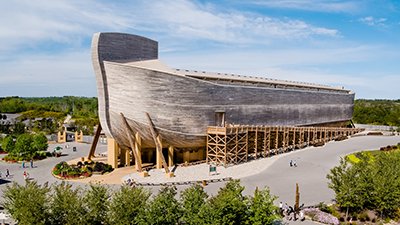Media Misrepresentations Mount
An Update on the Media Coverage of the Ark Encounter
The two major newspapers in our state have been quite hostile toward the Ark Encounter and its goal of bringing parts of the Bible to life and presenting these biblical events as true history.
[Editor’s note: This article is an adaptation and update of Ken Ham’s blog item that appeared over the weekend.]
Last month we posted a web article exposing misrepresentations that have been made by some in the mainstream media plus dozens of bloggers regarding the future Ark Encounter in Northern Kentucky. The centerpiece of the Ark Encounter complex—to be located in Williamstown, about half way between Lexington, Kentucky and Cincinnati, Ohio—will be an all-wood, full-size (500 feet long) Noah’s Ark. It is a joint effort between Answers in Genesis, which will design and operate the attraction, and the Ark Encounter LLC, which is made up of a group of investors. The two major newspapers in our state have been quite hostile toward the Ark Encounter and its goal of bringing parts of the Bible to life and presenting these biblical events as true history. The Louisville paper, the Courier-Journal, the largest paper in the state, and the Lexington newspaper, the Herald-Leader, have featured several articles and editorials in the past several weeks that have attacked the Ark project (as well as Democratic Gov. Steve Beshear for supporting its construction).
On Sunday, the Louisville Courier-Journal continued its broadside against the Ark.1 It interviewed people in the theme park industry for their views on the Ark Encounter’s attendance projections when it opens in 2014. They are reported to be skeptical about the Ark’s future success. Yet since these theme-park people have not conducted any kind of study (to our knowledge) on such an attraction, its location, potential audience, theme, etc., their opinion that the Ark’s estimated attendance figures are exaggerated is mere guesswork and not based on any hard data.
The article raises a question: why is the Courier-Journal even concerned with possible attendance at the Ark? If the attraction does not meet its projected figures, the state government and its citizens are not impacted—except positively, in that the attraction will still produce state sales tax to benefit Kentucky and its citizens regardless of the attendance. So why the paper’s concern? Where is the story? Ultimately, what is the article’s author, an "investigative” reporter, supposedly investigating here? If backers of a tourist attraction like an amusement park with thrill rides would also want to locate in Kentucky and its feasibility study showed 1.6 million guests the first year, would the paper also “investigate”?
If the taxpayers and state government are not at risk with the Ark Encounter, then who in the world does the paper need to alert? The people at risk are the private investors. As a corollary, if the Courier-Journal would predict that its circulation numbers for 2011 will be higher than last year’s figure of 159,000, and it turns out that it falls short, is the Kentucky taxpayer affected? Would there be a need for a front-page story with thousands of words to “investigate”? (Actually, the state would be affected—negatively—if the Courier-Journal shrinks in circulation: the state would lose potential sales tax revenue derived from the sale of newspapers.)
We believe, based on previous Ark-related comments made in the newspaper, that the Courier-Journal’s opposition to the Ark Encounter has everything to do with the religious content of the project and the editors’ dislike for something that wants to show that the Bible is true from the very first verse.
Given the track record of the Courier-Journal, our conclusion is that the paper’s editors are trying to discourage people from getting behind the project by employing scare tactics to try to move the Ark Encounter out of state.
Over the past few weeks since the Ark Encounter was announced by Gov. Beshear, it has been unfortunate to read articles by many journalists and bloggers who have intentionally, it appears, left people with a totally wrong impression about the state’s involvement in the Ark project. Several of them have either given false reports or have left the impression with readers that the Ark project will be a drain on Kentucky’s state revenues through offering tax incentives. That was the case again with the Courier-Journal in its latest long article. No mention of the nature of the incentives (i.e., a rebate) was presented.
To be clear: the incentives, in the form of a rebate of sales tax we collect at the Ark (on tickets, food, and merchandise) will not be a grant of state funds to help build the Ark Encounter; no money to either build or operate the Ark Encounter will come out of the state’s pocket and away from its programs (e.g., social services, schools, etc.).
Only recently, after a few of its misleading Ark articles had appeared, has the Louisville Courier-Journal paper even mentioned the true nature of the incentives and the rebate (and in an article several days ago it was made only in passing and further down the piece), For weeks, the newspaper was leaving readers with the impression that the Ark would be a drain on state revenue. With Sunday’s long article in the Courier-Journal, it has happened yet again: readers are given the wrong idea that money is coming from the state budget to help fund the Ark Encounter. (More about this ongoing misrepresentation will be discussed in the second half of this article.)
Sunday’s article was problematic in another way. The report is wrong in its claim that Gov. Beshear has indicated that the state has already decided that it “would give tax incentives” to the Ark Encounter. No, the state is still reviewing our application. Just because the governor supports the project does not mean the Ark has received the state’s OK to receive a rebate of sales tax; there is a lengthy and expensive process, and it is the Ark’s backers who pay for the feasibility study that Kentucky commissions. (A few lines later, Sunday’s article quoted a staff member in the governor’s office who stated that the state has not granted the request. This flatly contradicts the reporter's statement a few sentences earlier that the state has already decided that it “would give tax incentives” to the Ark.)
Once again, the Courier-Journal unfairly chided Gov. Beshear for not looking at our Ark feasibility study before he announced the project last month. But the massive study was not essential for him to read because the governor was aware that before Kentucky could approve the rebate of future sales tax to be collected at the Ark, the state would need to commission its own study to determine the proposed attraction’s attendance and revenue. Our ARG-commissioned study simply got the foot in the door to encourage the governor to look into our project. The fact that the governor did not see our feasibility study is immaterial; the state’s future Ark study is what is material.
With this article, we will deal with two major themes related to the Ark Encounter’s opponents: 1. to share reasons why the Ark may attract some very large crowds, contrary to what detractors are claiming (including what some people said in Sunday’s Courier-Journal) and 2. to correct the misreporting of so much of the media, especially in our state newspapers.
1. Will people come to the Ark when it opens?
Here are several reasons why the Ark Encounter has a legitimate shot at seeing 1.6 million people a year when it opens (projected to be 2014).
a. First, we should point out that there is something of a proven track record with our Creation Museum. In the first three years of operation, museum attendance (over one million visitors) has been beyond projections (even in a difficult economy). Before the museum opened, however, skeptics (and even some Christians who disagree with us over the Book of Genesis) predicted the museum would fail because few people would come. They were dead wrong, and now in 2011, we have our naysayers once again.
Also, the quality of the exhibits has drawn rave comments. Even many of the museum’s detractors have admired the museum’s high-tech displays and presentations.
b. A great boon to the Ark project will be the fact that the same team that designed and built the successful Creation Museum is returning for the Ark Encounter.
c. Most important in this list of reasons that Ark Encounter should be successful in reaching the 1.6 million mark in year one is the Ark survey conducted by the renowned America’s Research Group (ARG). The nationwide study we commissioned to estimate the attendance at the Ark Encounter indicated that over 1.6 million people would visit the first year. Before the Creation Museum opened in 2007, an ARG feasibility study estimated that the museum might see 400,000 people come the first year, as opposed to our original estimate of 250,000. The eventual attendance was 404,000. ARG’s study was right on the mark. Given ARG’s accurate forecast for our Creation Museum and its national reputation in successfully predicting consumer behavior, we think the 1.6 million figure for the Ark is a solid (if not overly conservative) estimate for the first year of operation.
d. Mr. Cary Summers of the Nehemiah Group, the main consultant for the Ark Encounter (and who was interviewed by the Louisville paper for Sunday’s story), has been involved in the theme park industry for three decades. Mr. Summers was the CEO of Herschend Family Entertainment group in the 1990s; during Mr. Summers’ tenure, Herschend owned and operated 14 themed locations (including Silver Dollar City, Dollywood, Stone Mountain, and many more). His expertise is vital to the Ark project’s success.
Mr. Summers commented on those people who are doubtful of the Ark’s success: “We had one of the leading research groups in the country, ARG, conduct a general population survey which showed the potential visitation. ARG has been providing customer-behavior information to hundreds of industry leaders in numerous fields for the last 30 years. We in turn took those detailed projections and had one of the leading theme-attraction research groups review the projections and conduct a second survey. Both surveys support the attendance projections we have announced and the economic impact the project will have on the region.”
Summers added: “These surveys and studies were then coupled with data gathered from the over one-million visitors who have visited the Creation Museum over the last three years, providing us with additional information as to the potential visitation and the financial results that might be expected at the Ark Encounter. All data and survey information gathered adhered to strict methodologies required to derive statistically correct conclusions as to who and how many people will attend.”
Summers closed with the observation: “The only way to draw a conclusion as to the potential success of such a project as the Ark Encounter is to study all the data; use industry experts to develop financial projections and operating scenarios; and take into consideration the potential economic climate that could exist over the next several years. If you try to draw a conclusion as to the potential success of any project of this size without going through these steps, which took over two years for us to develop, it is futile, for it is based upon superficial thin air.”
“Our conclusions, however, are based upon valid research and many years of industry experience.”
e. We point out that ARG’s extensive feasibility study indicated that interest (nationwide) in the topic of the Ark crosses religious lines (including those who are irreligious). ARG’s national study showed that hundreds of thousands of irreligious people will come out of curiosity each year to see this massive ship.
f. The CBS 60 Minutes / Vanity Fair on-line poll that was conducted in late 2009 revealed that the archaeological discovery most people wanted to be made next is Noah’s Ark. The response: Noah’s Ark (43%), Atlantis (18%) Amelia Earhart’s plane (16%), Nixon’s lost tapes (13%), and Cleopatra’s barge (5%).” Interest nationwide in a full-size, all-wood Ark is substantial.
g. Geography will play a big role in helping to bring many tourists to the Ark Encounter. Almost 2/3 of Americans live within a one-day drive (less than 650 miles) of the Ark site in Williamstown, plus several million Canadians are within an 8-hour-drive.
h. Mr. Summers points out that a tourist attraction like a theme park is one of the most dynamic industries a state can pursue, and he predicts that the Ark Encounter will attract over 80% of its guests from out of state.
i. Anecdotally, many Creation Museum visitors have been encouraging AiG to build a full-scale Noah’s Ark after they viewed the impressive Ark-related exhibits inside the museum.
j. Consider this as well: we have no reason to inflate the estimated number of people who might come to the Ark Encounter. First, we don’t want to be wasteful and buy more land than is necessary to accommodate the number of people. If anything, we want to be conservative with the estimated figures and save on land costs. Second, the state is commissioning an independent study (which we pay for) regarding the number of people who might come to the Ark, as well as the associated economic impact for the state. (Our feasibility study is moot as far as the state is concerned in making its decision if it will offer a sales tax rebate.)
k. Just as God blessed the Creation Museum amidst tremendous secularist opposition it received several years ago, we are confident He will also bless AiG’s latest effort to build yet another complex that will honor and defend His infallible Word.
2. Media Misrepresentations of the Ark Encounter
As mentioned above, widespread media reports have wrongly stated or implied that the Ark Encounter will be a drain on the state’s budget. This crucial omission happened again with the Courier-Journal in its Sunday article.
The tax incentives come in the form of a rebate of sales tax that we will collect at the Ark (on tickets, food, and merchandise). No state funds will be used either to help build the Ark Encounter or operate it when it opens. On the contrary, and as we will share later, the state’s treasury will greatly benefit from the revenue generated at the Ark and nearby tourism-related businesses that will help the state fund its needed services.
Indeed, that aspect has largely been omitted by the press. The state’s coffers will actually benefit tremendously when the Ark opens. The part of the sales tax that the state will keep, plus payroll and property taxes collected from the 14,000 people who are projected to be eventually working in the region at the Ark Encounter and at other new businesses that will be created, will be significant. Also, the sales tax collected by the many newly created local businesses through the Ark’s ripple effect will also add revenue to the state coffers (e.g., the sales taxes collected by hotels, gas stations, restaurants, shops, etc. in the region).
Bottom line: Kentucky taxpayers will not pick up the tab, and there is no financial risk to the state in the construction and operation of the Ark if the tax rebate is approved. Furthermore, think of it in this way as well: the state wouldn’t collect any sales tax from the Ark Encounter if it was never built. Moreover, if the Ark Encounter moves out of state, not only will hundreds of millions of dollars in sales tax revenue be lost to Kentucky, but so will several thousand jobs. Plus, the sales taxes, property taxes, and other applicable taxes collected by the state, city and county—which would far exceed the rebate offered to the Ark Encounter—will also be lost. This all seems so obvious, but if reporters don’t have much background in basic economics, they may miss the significance of the rebate plan – or intentionally hide the rebate aspect from readers if they really do understand the nature of the rebate.
As we look back on the terrible reporting by the Louisville and Lexington newspapers on the nature of the tax incentives (especially the omission of essential information), we now have a much better understanding of the significance of the admonition: “Tell the truth, the whole truth, and nothing but the truth.” While there are instances in which newspapers can present information accurately, when they omit key information, they can leave a totally wrong impression with their readers.
With many reporters/editors, they apparently hope the reader will connect some dots for themselves and arrive at a wrong conclusion, especially when they write things similar to “tax incentives from the state will be offered to the Ark Encounter and the Ark will receive money from the state.” The unwary reader is led to believe from such comments that the project will be a drain on state revenue. This kind of tactic is not ethical when that reporter doesn’t mention what is clearly a rebate offered through the Tourism Development Act of Kentucky.
To summarize the impact in the state: once the Ark Encounter opens, the total economic impact is expected to be $500 million in the first year alone (including final construction on the Ark project itself). The only people to pay taxes related to operating the Ark will be the Ark Encounter visitors: they will pay sales tax at the attraction (e.g., on tickets, food, and merchandise), and the state – through its Tourism Development Act -- will rebate a portion of the sales tax to the Ark Encounter LLC based on meeting attendance-performance marks.
As Lou “Steve” Stevens, the president of the regional Northern Kentucky Chamber of Commerce observed in a December 2010 letter to the Herald-Leader: “Kentucky taxpayers will not pick up the tab and there is no financial risk to KY. This is not ‘stimulus funding’ in that no money will be taken out of the state budget to fund the Ark’s construction or its operation. . . . Additionally, many different taxes will be paid by the numerous indirect business activities created by the massive project.”
In fact, the Ark has already had a positive economic impact on the state. Six employees working on the Ark project (many more to be hired this year) have been paying payroll taxes for over a year now. There have been travel dollars spent in the form of airport taxes, fuel, meals for regional trips, and hotel stays (both guest rooms and conference rooms) related to the Ark. Additional offices and a warehouse are being rented. And that’s all with no ground having been broken yet in Williamstown.
Also, because of the expected increase in attendance at the Creation Museum when the Ark opens, there will be a need for expansion at the museum. That has already started, as a 1,000-seat multi-purpose auditorium is now under construction next to the museum. You can ask local contractors if they think that the Ark is already having a positive economic impact on the economy.
In the final analysis, it appears that many of the Ark’s critics are far more concerned about the state supporting tax incentives for an attraction featuring elements from the Old Testament than they are about unemployed people (10% unemployment in Kentucky) and a cash-strapped state that is desperately seeking additional revenue to balance its budget and provide needed services. And there is no risk to the state. If the Ark doesn’t achieve the attendance figures, then its portion of the rebated sales tax is lowered, and the state still keeps the rest of the sales tax. It’s the proverbial financial “no-brainer”—there is no risk to the state.
Attacks on the Ark Encounter project only help to reveal the nature of many Ark detractors, who are so set in their beliefs that they will not even consider how this family-friendly and economically sound attraction will be a great asset to the state during difficult times. Such bias seems to have clouded some reporting and has ultimately misled readers about how the Ark Encounter will really be funded.
Yet that may be the price that some Ark Encounter critics in Kentucky are willing to pay in order to advance their agenda.
With Sunday’s Courier-Journal article, we want to make an observation about a comment made by a person who works in the theme park industry. He declared that the Ark will “alienate” many people because of its religious content. But almost 2/3 of the people surveyed by ARG indicated that they would consider visiting a full-size Ark. Furthermore, we have been surprised to have seen so many skeptics at the Creation Museum and blogging about it afterwards; these are people that the paper would argue would be alienated by a visit to a place that challenges their evolutionary worldview, and yet they come. According to the ARG survey, the Ark has more broad appeal than a creation museum.
We point out, too, that millions of people do not go to amusement parks because they don’t care for thrill rides like roller coasters. So with any theme park, a segment of the population will be “alienated.” However, when the question was asked, “Would you visit a full-size Ark if it were built?,” ARG discovered that 63% of the population nationwide said yes.
We are curious how people in the theme park industry (some of them might be considered competitors of the Ark Encounter) can speak knowledgeably about a project where they know little of what we intend to do and have no data to draw from, whereas we have conducted our own thorough study of the Ark Encounter’s feasibility with a national survey. The Ark’s doubters are flying blind.
Again, if the attendance projection of 1.6 million people is not met, the state is not at risk. If attendance is lower than expected, then our portion of the rebated sales tax is lowered, and the state still keeps the rest of the sales tax. The state is not on the hook.
Conclusion
We are aware that newspapers are struggling for survival in our electronic age. Thus to keep up their circulation, they are prone to stir things up to create headlines. In fact, in the few days leading up to Sunday, the Courier-Journal had a prominent banner on its website to inform the paper’s internet readers that in order for them to read Sunday’s investigative article on the Ark Encounter, they would have to purchase a paper. The Ark article was to be a “print exclusive” and not available free on its website on Sunday. We don’t begrudge the paper’s editors for wanting to see stronger circulation numbers, as long as it’s done with the right journalistic reasons. In today’s challenging newspaper climate, non-stories often become stories to sell papers.
In the case of the Courier-Journal, balance and accuracy have been lost in its coverage of the Ark Encounter. To be fair, some media outlets have been accurate in their reporting on the Ark project, even as they quote the Ark’s opposition (which is to be expected from the press). But the two Kentucky newspapers have been relentless in their attacks on the Ark Encounter as they push an anti-Christian agenda.
To make a donation to the exciting Ark Encounter and sponsor a part of the Ark, go to https://arkencounter.com/donate/
Footnotes
- The Louisville Courier-Journal article has yet to appear on the paper's website as we are posting this rebuttal, and so we can't provide you with a web-link to the piece.
Recommended Resources

Answers in Genesis is an apologetics ministry, dedicated to helping Christians defend their faith and proclaim the good news of Jesus Christ.
- Customer Service 800.778.3390
- Available Monday–Friday | 9 AM–5 PM ET
- © 2026 Answers in Genesis






